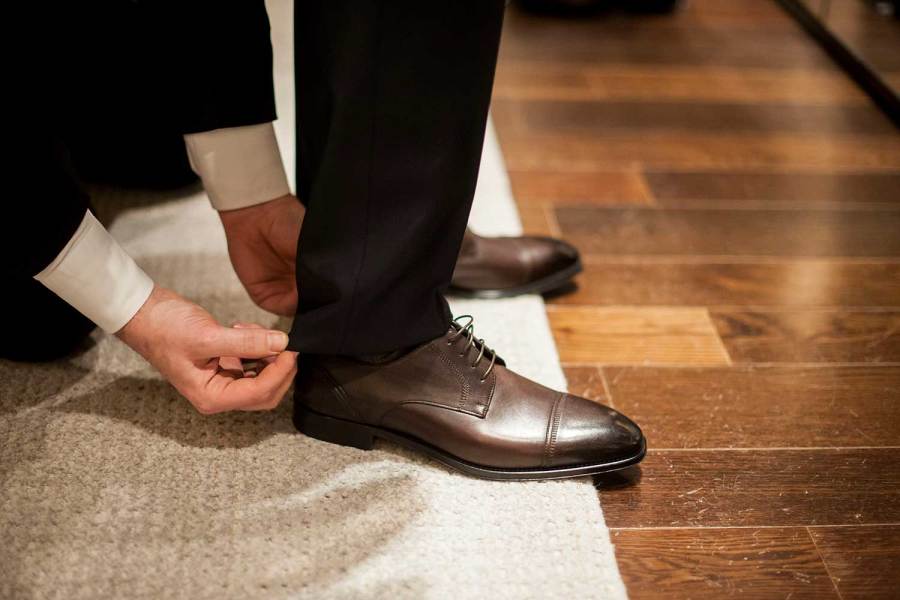Shared from He Spoke Style
Suits look good because of their simple and clean design and when you leave the tag on the sleeve, it creates an unintended focal point and distracts from its overall appearance.
So just like you did with the tack stitching, when you get your suit home, take a pair of scissors, carefully cut the thread around the tag, and remove it.
If you’re suiting up, you want to look the part. So be sure to remove that label!
3. Buttoning Suit Jacket Incorrectly
Buttoning a suit jacket might seem pretty simple. But not doing it properly is a very common beginner suit mistake.
There are three common suit jacket styles, each with its own rules for proper buttoning: two-button, two and a half button (also known as a “three roll two”), and a double-breasted jacket. Let’s take a quick look at each.
Two button jacket. A two-button jacket is just what it sounds like–there are only two buttons. That means you’ve got a 50-50 chance of getting it right (or wrong)! With a two-button jacket, always button the top button, never the bottom button, and never both at the same time.
Two and a half button jacket. A two and a half button jacket has three buttons–don’t let the name fool you–and an extra button hole folded into the lapel.
Here’s a simple trick to remember which buttons to button: sometimes, always, never.
Always button the middle button.
If it’s colder outside and you’d like a little more coverage, you may sometimes choose to button the top button along with the middle button.
But never button the bottom button.
Don’t forget: sometimes, always, never.
Double-breasted jacket. The most important thing to do when buttoning a double-breasted jacket is to button the inner button. This button is also called the “anchor” button and it helps the jacket properly lay against your body.
A standard double-breasted jacket will have six buttons that show. For a clean look, button both of them. Or for a little more Italian style and panache, just button the top button. Both methods are acceptable.
4. Poorly Fitting Suit Jacket
If you’ve just started getting into men’s style, you’ve likely heard the saying, “Fit Is King.” It’s true. A properly fitting suit just looks better and it makes you look better.
There are a lot of fine details when it comes to getting the perfect fit for your suit, but one we’re going to focus on proper jacket fit because a poorly fitting suit jacket is one of the most common beginner suit mistakes.
Four key areas to discuss how to get the proper fit:
1. Shoulders
2. Jacket length
3. Sleeve length
4. Body
Shoulders. The jacket’s shoulder seam should end right where your arm starts to break downward and the sleeve should follow that line and flow smoothly down your arm. There should be no visible bunching or puckering at your shoulder. This is important to get right the first time because it is nearly impossible change the size of a jacket’s shoulder with alterations.
Jacket length. Here’s a simple way to determine if your jacket is the proper length. Stand with your arms at your side and make a fist. If your fingertips are just touching the bottom of the jacket, that’s the proper length.
Sleeve length. For the ideal jacket sleeve length, the sleeve should end at your wrist bone.
Body. When you button your jacket–properly, of course–should have have a small amount of play between the jacket and your body. Also, when buttoned there should be no pulling or bunching. If you see any sort of stress, this is a sign that your jacket is too small.
While minor alterations can fix most of these issues–aside from the shoulders–there is a limit to how much or how far a garment can be altered. That’s why it’s important to get as close as possible the first time.
5. Thinking Alterations Aren’t Necessary
And that brings us to our final beginner suit mistake: thinking that alterations aren’t necessary.

With such a wide range of sizing and variety of fit options offered, it’s natural to think that you’re getting a fit that is far superior than your typical S, M, L, and XL clothing. And if you’re getting a custom suit, that’s even more true, right?
Yes and no.
Everybody is different. And every body is different.
Having a suit fit great is all about precision. And precision in many different areas. While you may be close to a perfect fit with an off the rack suit, chances are you’ll still need a few minor alterations to really dial it in.
Same goes for a custom suit. Yes, with a custom suit you’re getting much more control over exact sizing, but even custom suits will require a minor alteration or two once they come in.
FURTHER READING: A Complete Guide to Suit Alterations
The name of the game here is expectation management.

As long as you go into the suit buying process knowing that there there will be alterations necessary, you’ll be fine. Just be sure to build some time in to get them done. In other words, if you need a suit for an event, don’t wait until the day before to go out and buy one!
It’s also worth remembering that tailoring is an art, not a science. Find a great tailor and give them some time to get your alterations done.
Final Thoughts
If you’ve read through this article and found that you’ve made some of these beginner suit mistakes yourself, don’t feel bad. We’ve all made mistakes along the way on our style journey. (As a matter of fact, here are some of my worst outfits ever.)
It’s a process and you will continue to learn. That’s the best part.
Thanks, as always, for reading.
Stylishly Yours,
Brian Sacawa
He Spoke Style
Images and Article from He Spoke Style



